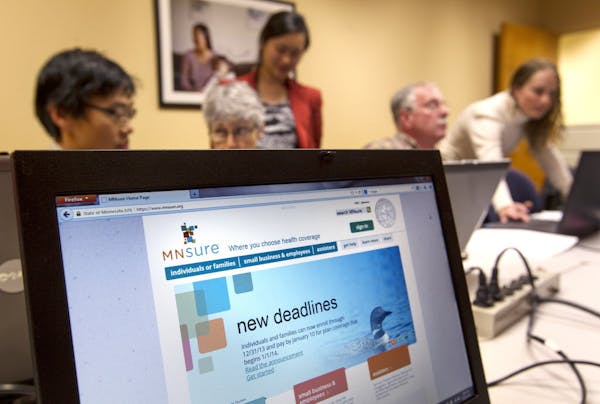One trouble after another plagued MNsure, the state's health insurance exchange, when it debuted last year.
People struggled with the website. Calls for help led to hourlong waits. Advisers who were supposed to help people use the new system instead felt thwarted by it.
Ultimately, the turmoil forced the departure of MNsure's executive director and stoked a partisan debate — even as more than 350,000 Minnesotans connected with coverage.
This week, as MNsure opens enrollment again, state officials are touting system improvements while also cautioning that everything still may not work perfectly — a tricky mix of messages that reflects the high stakes.
"Last year, there was a lot of business that went directly to the health plans, because MNsure was in such trouble," said Stephen Parente, a health finance expert at the University of Minnesota. "This is the year to see whether MNsure is going to live up to its promise of really being the marketplace for private health insurance."
In a last-minute scramble to avoid a repeat of troubles, state officials are pushing a series of website fixes and final contingency plans designed to make sure consumers have a better experience. At the same time, they're trying to broadcast the message that if consumers don't give the exchange another shot, many could lose out financially.
MNsure has a financial interest as well, since the exchange must eventually pay for itself. MNsure keeps a small percentage of the premiums on commercial policies sold through the exchange.
Minnesota launched the online marketplace in October 2013 to implement the federal Affordable Care Act, which requires almost all Americans to have health insurance or pay a tax penalty. The exchange is an option for state residents who buy insurance as individuals, rather than as part of employer groups or government programs such as Medicare.
Open enrollment starts Nov. 15. If the website flops, MNsure officials will tap an incident command center to promote alternatives such as paper applications, MNsure chief executive Scott Leitz said in an interview.
But the chance of a complete website failure is "highly, highly unlikely," Leitz said. If there are problems, it's more likely they'll involve "sub-functions," he said, such as determining financial assistance for families where parents and children qualify for different government programs. In those cases, the state has plans to direct people to one-on-one assistance.
"If you think back to last October and the system that was in place, and you compare that system to what we will have in place November 15, it's light-years different," Leitz said. Of the website, he added: "The core system is much more stable."
Renewal outside MNsure
The majority of those who bought coverage through MNsure will find the path of least resistance steers them away from the exchange, since their policies will automatically renew outside of MNsure. That's because PreferredOne — the largest source of commercial coverage on the exchange this year — and certain policies from two other insurance companies won't be offered on the exchange for 2015.
As a result, about 75 percent to 80 percent of current MNsure customers won't renew on the exchange, unless they actively come back to MNsure. But the health exchange is the only place where people can qualify for federal tax credits that discount the cost of health insurance premiums.
"If those people don't act, that means they get renewed outside the exchange, which is a problem — because they will renew without a subsidy," said Caroline Pearson, a vice president with Avalere Health, a health policy consulting firm in Washington, D.C. "It's a huge issue in Minnesota — and it's only in Minnesota."
MNsure officials are squarely focused on sending the message that "everyone should come back through and shop in the system," Leitz said. Premiums in the state will be higher in 2015, so more people will qualify for tax credits.
At the same time, state officials are trying to set cautious expectations for how the website will work. At a board meeting Wednesday in St. Paul, Brian Keane of the consulting firm Deloitte said the state and its IT vendors had identified about 10 key "blockers" that could adversely affect the website's performance. Fixes for most were being deployed, Keane said, but the exchange still needed to test the fixes — work that will continue until Nov. 15.
"We're optimistic at this point that we can get through them," Keane said, "but at this point there's just no guarantee."
The infrastructure and base settings for the IT system have been expanded and are more robust, said Jesse Oman, an assistant commissioner with MN.IT, the state's information technology division. But as MNsure has made changes for the upcoming open enrollment season, testing revealed "some hot spots" that require the last-minute fixes, Oman told board members.
"Once that is in place — and if it tests out — we are on the cusp of being able to deliver a much better customer experience," he said. "But we need to continue to go through all of the [test] cycles."
"This is a high-risk project from Day One," Oman said, "and it remains a high-risk project."
In an interview, Leitz said he agreed with the "high-risk" description, saying it reflects the exchange's tight deadlines and status as a system that's in testing. "That's a word you wouldn't have heard last year, because we didn't do testing last year," Leitz said.
Although the website suffered crashes last fall, that didn't happen during a second big enrollment surge in March, Leitz said. Increased staffing and improved technology helped the MNsure call center and website better withstand the close of open enrollment this spring, he said.
Knowing what to expect
Last week, call center wait times averaged less than a minute, Leitz said, thanks to a staffing surge that will continue through the coming open enrollment. MNsure customers can get help this fall from a network of some 3,000 agents, insurance "navigators" and other assisters, he added. That's about twice the number available last fall.
"People this year know it's high risk," Leitz said. "They didn't know that last year."
Counselors are also much more familiar with the MNsure system this year and know how to work through glitches, said Rebecca Lozano of Portico Healthnet, a St. Paul-based nonprofit that employs insurance navigators.
"I think there are a lot of changes they have made to the system that have significantly improved its function," Lozano said.
Others aren't convinced.
People looking for coverage that starts Jan. 1 will have only one month to shop, said Eric Anderson, an insurance agent in Mendota Heights. That's a tight timeline, he said, especially since even those who are returning to the exchange for coverage will need to fill out a new application for coverage.
"MNsure is going to be worse than it was last year — because they're going to have to rewrite all their clients," Anderson said.
Joe Campbell, a MNsure spokesman, said filling out the application takes about 25 to 30 minutes. It helps consumers, he said, because they will be able to shop with an updated estimate for tax credits.
Returning MNsure customer Steve Briggs of Eagan said he expects to be annoyed with having to repeat the process "because it's inefficient."
Enrolling through the exchange for 2014 was an ordeal, Briggs said, calling MNsure "by far the worst website I have experienced in my life." Even so, he's a current PreferredOne subscriber who expects to be shopping on the exchange again this fall.
"I have to have medical," said Briggs, 59. "I also believe I'm going to get a meaningful tax credit, and I don't want to leave that on the table."
Christopher Snowbeck • 612-673-4744
Twitter: @chrissnowbeck
Jury selection could be nearing a close in Donald Trump's hush money trial in New York

